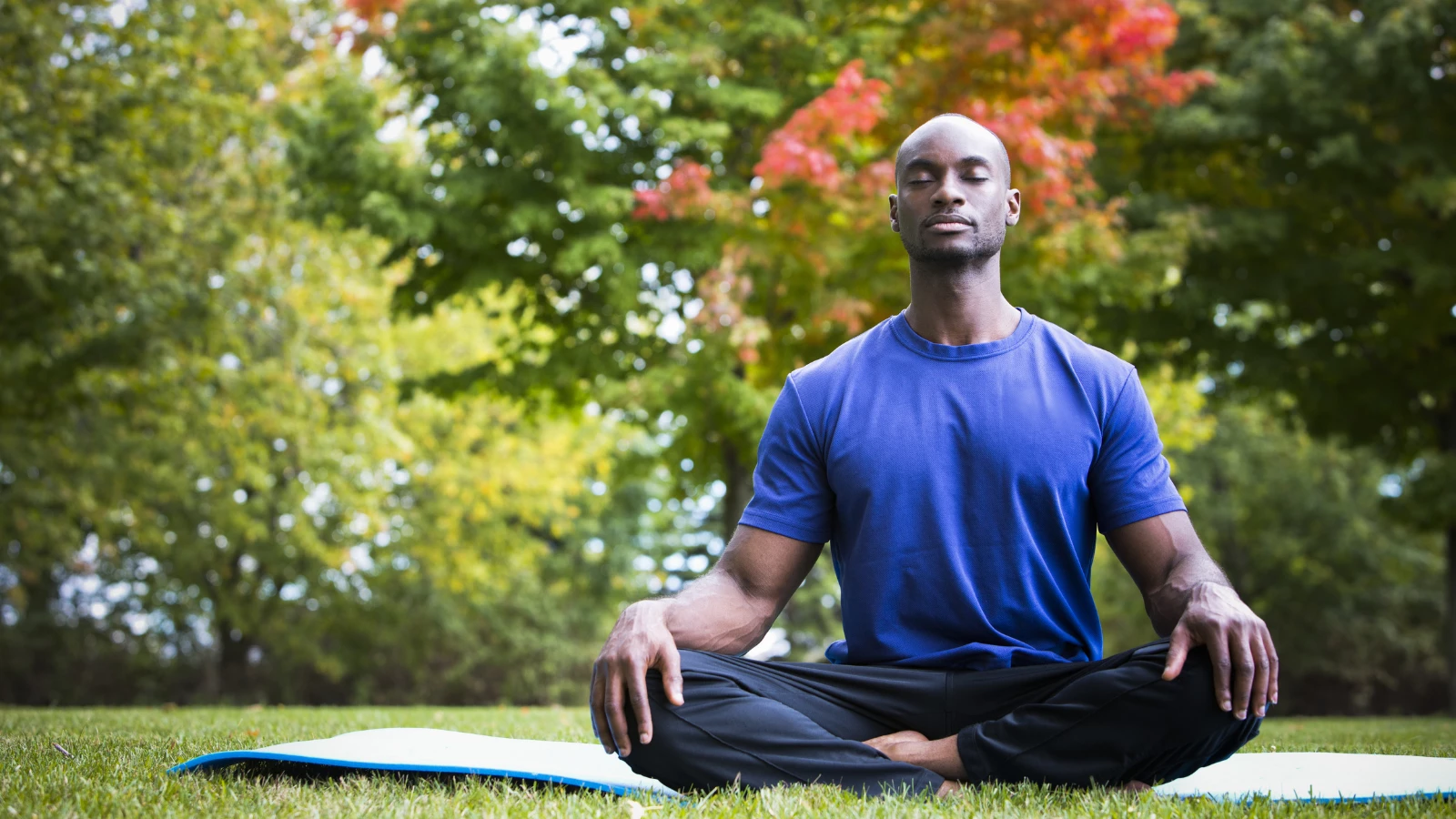COVID-19 Pranayama: A Yogic Breathing Practice for the Pandemic

Article At A Glance
It all started with a short video that came across my YouTube feed about a month ago. And a brief one at that, just 3:42 long. But despite its brevity, its content caught my attention immediately: a breathing technique that hospital staff in the UK were teaching to their patients with COVID-19 who had respiratory symptoms. It resembled a type of COVID-19 pranayama.
It was fairly simple: take a big breath in, hold it in for five seconds, let it go. Repeat that six times and on the sixth round, cough once or twice into your elbow. Do another set of six. Then, lie down on your belly, prone, with your chest and head slightly propped up with a pillow, and take slightly deeper breaths for about 10 minutes.
The reasoning for the prone practice is that more of our lung tissue is in the back half of the lungs, and if we are lying on our backs in bed, sick, this area gets compressed by gravity and not utilized fully, compromising our ability to get needed amounts of oxygen into our bloodstream, and possibly increasing our chances of getting secondary pneumonia. Lying on your belly and breathing opens that lung tissue up for use.
I then came across another video, made by a doctor in the US, describing essentially the same technique. Something was brewing out there! He mentioned that these techniques seemed to be keeping hospitalized patients off the ventilators!
COVID-19 Pranayama: Smoothing the Breathing Process

Right away, I saw that our yoga pranayama practice might enhance this technique. For example, the doctor who demonstrates the technique in the UK video mentions, offhandedly, that he got lightheaded while doing the technique. In all likelihood, he was hyperventilating a bit, due to the quick deep breath in and the causal breath out. Also, over-gripping while holding the breath in for five seconds that I witnessed might have affected him.
I wondered if evening out the inhalation and exhalation and holding the breath more gently for five seconds might alleviate this unwelcome and possibly discouraging (to patients trying it) symptom, while still opening up the lungs? (Always alert to possible cautions with pranayama techniques, I’d suggest those with blood pressure issues be more cautious about the kumbhaka hold at the top of the inhalation, by monitoring their blood pressure before and right after the practice to make sure there is not an unusual spike in their numbers.)
Yoga’s Sphinx Pose and “Proning” for Better Breathing
And the second part of the practice sounded like a low-supported Sphinx Pose (Salamba Bhujangasana), and with proper propping, could be done comfortably in bed or on a sticky mat. Lying on the belly is not always comfortable for all people, so creative propping might need to be explored to make this more doable for those people, and one might even break this up into two five-minute sessions, with a Cat-Cow Pose (Marjaryasana-Bitilasana) in between to relieve any symptoms in the spine.

(Image above is of Sphinx Pose, but for Baxter’s practice below, you’ll need to add a pillow to support your chest-see part 2 below)
And then, just last week, this article appeared in The New York Times, describing a new trend of having ICU patients with COVID-19 lung involvement lie on their belly when on the respirator, and even prior to considering placing them on the breathing machines to try and avoid the need to do so. They call it “proning” and it is lowering the death rate in early investigations, as well as the need to place patients on ventilators.
How to Practice COVID-19 Pranayama
With all this in mind, I started to practice the Part 1 technique in my morning meditation/pranayama practice in the following way:
- Inhalation for 5 seconds, gentle pause at the top of the inhalation for 5 seconds, exhalation out for 5 seconds, for five rounds of breath, and on the 6th breath, instead of a 5-second exhalation, 2 short, strong coughs.
- Repeat that again.
Interestingly, although I had always been taught and read that holding the breath in after the inhalation (a kumbhaka) was stimulating to the nervous system, I have found that this particular way of doing it was neutral in effect for me, and I actually feel pretty calm and relaxed after 2 cycles most days.
Here’s how I practiced Part 2:
- I had a pillow at my mat when doing my asana practice, and at the end of practice, set myself up in Low Sphinx Pose with a pillow under the upper chest and the head supported on stacked fists.
- I gently lengthened the in and out-breath for 5 to 10 minutes, setting a timer so I did not have to worry about how long I had been practicing. I found this very accessible and actually quite calming and relaxing!
Practice COVID-19 Pranayama Before Coronavirus Strikes
If indeed, this two-part technique of breathing practice is potentially beneficial for the recovery of those who get COVID-19 respiratory symptoms, it might make sense for everyone to practice it ahead of time, as Dr. Munshi in the UK suggested, and be ready to use it more consistently if and when the need arises. Although the benefits are anecdotal at this time for Part 1 of the process, (the ICU use of prone breathing is being studied and already has evidence of value) it seems like the potential benefits of doing it far outweigh any negative side effects for the vast majority of people it could help.
Try it out yourself with my video below. I’d love to hear about your experience with the practice: what worked, how did it feel, what was challenging. If you find it of value, spread the word!
Also, read...
Teaching Svadhyaya: 3 Ways to Encourage Self-Study in Yoga
Dec 15 – Meagan McCrary
In Celebration of Gray-Haired Yoga – Busting the Myth of the Yoga Body
Dec 12 – Charlotte Bell
Related courses
Reprinted with permission from Baxter Bell.com.

Baxter Bell, MD, C-IAYT, YACEP, fell in love with yoga in 1993 while he was working full-time as a family physician. His appreciation for the potential of yoga to foster health, healing, and equanimity was so great that he soon stepped down from his medical practice and trained to become a yoga teacher. Now, he focuses on teaching yoga full time, both to ordinary students of all ages and physical conditions and to the next generation of yoga teachers and yoga therapists, to whom he teaches anatomy and yoga therapy along with his accessible, skillful style of yoga. He also sees students privately, helping them use yoga to help heal from and/or cope with a wide range of medical conditions. At this point, with 23+ years of teaching experience under his belt, Baxter brings a unique perspective to his teaching, combining his understanding of anatomy and medicine with his skill at instructing people from all walks of life and all levels of ability.
In addition to teaching classes, workshops, and retreats internationally, Baxter is a past presenter at Yoga Journal Conferences and the International Association of Yoga Therapy’s Sytar Conference and teaches online courses and classes at Yoga U Online. Baxter is also the co-author of the popular and ground-breaking book Yoga for Healthy Aging and his blog, “What’s On Your (Yoga) Mind,” where he shares his knowledge of medical conditions, anatomy, yoga, and more with practitioners and teachers across the world. He has written articles for the Yoga Journal and the Journal of the International Association of Yoga Therapy. He is often quoted as an expert on yoga and health by major national news outlets such as the Washington Post and the Wall Street Journal. To learn more, visit www.baxterbell.com, and his YouTube channel and Instagram page at Baxter Bell Yoga.
Recent articles
Teaching Svadhyaya: 3 Ways to Encourage Self-Study in Yoga
Dec 15 – Meagan McCrary
In Celebration of Gray-Haired Yoga – Busting the Myth of the Yoga Body
Dec 12 – Charlotte Bell
Categories
Upcoming courses
Reconnecting with Strength: Your Path to Building Greater Inner Resilience
With Arielle Schwartz
Recent articles
Almost there...
Sorry, we couldn't find anything...
Yoga Practice Tips
Teaching Svadhyaya: 3 Ways to Encourage Self-Study in Yoga
As yoga teachers, our job is to teach yoga. This means more than…
Dec 15 – Meagan McCrary
Yoga Practice Tips
In Celebration of Gray-Haired Yoga – Busting the Myth of the Yoga Body
I found my first grey hair when I was 22. It wasn’t completely shocking.…
Dec 12 – Charlotte Bell
Yoga Practice Tips
Judith Hanson Lasater on The Art of Teaching Yoga: Making Every Movement an Asana
Judith Hanson Lasater is one of the longest-teaching yoga teachers in the U.S. In…
Dec 09 – By:



